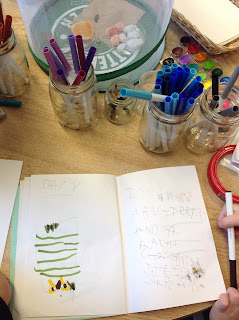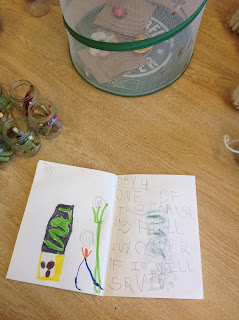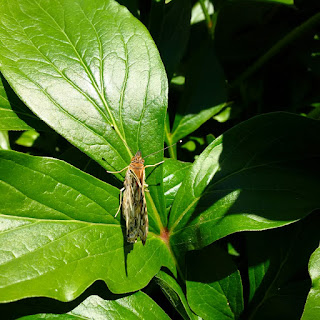Below is an example of how I progress through an inquiry with the children. It is a very unstructured method that seems to work well for the children and I. It is by no means a set way to run an inquiry nor does one really exist. It is rather a look at a few components that support the inquiry process and may be helpful with planning.
From caterpillars to butterflies...the beginning of our learning journey
I mentioned to the children that we were going to have some caterpillars in our classroom. We had a few weeks to wait for their arrival so in the meantime I got many books for them to peruse. I also placed some art materials at the Discovery Area enticing them to become more familiar with caterpillars and butterflies by means of sketching what interested them in the books they perused. Sticky pads were also available for the children to write/draw any observations, wonders, and theories they had and place them on the chart hung on our wall.
The arrival of our caterpillars!
Once the caterpillars arrived the children were given their own observation booklets (coloured cover with a few blank pages inside) to further support them in documenting any changes they may have observed throughout each day. There was no set time for the children to document in their observation books. Most of the children preferred to write in them during exploration time when they had more time to observe or they had the choice to use them during Log Book writing time. They documented as much or as little as they wanted. Of course whenever something exciting was noticed this sure increased the entries!
You may notice in the photos that the children had written the observation day number in their entries. This started from the use of a calendar to mark the arrival of our caterpillars and other important observations that were noticed. I was not at all concerned with the correct observation day number. I was just very pleased that they were aware to even make this an important item in their entries.



From chrysalis to butterfly!!!
I wish I videotaped the screams of excitement from the children and myself when we saw the first butterfly emerge from the chrysalis! As K. C. stated, "It was a miracle!". Within a few days the other butterflies also emerged. The children were ecstatic and quickly wanted to name them and make them welcome cards. Among the many names chosen by the children were Lucy, Willow, Zack, Spot, and Mrs. Ralph. How lucky am I!

Extending the learning through the arts
Aside from writing in their Observation Books, I wanted the children to have a tactile experience. Sketching with sharpies, and using plasticine, buttons, shells, pebbles, sequence, and wire, encouraged them to look closely at the detail of the butterflies and chrysalises we had or ones they found in books. The children paid close attention to symmetry, shape, colour, and texture. They mixed plasticine colours to achieve their desired shade, and figured out that by rolling the plasticine into a small ball with their palms warmed it up and made it easier to spread with their fingers onto the canvas. A lot of experimentation and innovation was involved in this provocation.
I do not have set times for Knowledge Building Circles. Rather I try to meet with the children and have these group discussions about once or twice a week. It really depends on whether something pivotal happened and the children have a lot to say or if I see that our wonder chart is getting full and we need to discuss some of the children's questions and theories. At times I also meet with children in a small group depending on who is interested in a certain discussion that has come up. It is a very unstructured and organic process that allows the children to dialogue with each other and move our thinking along. These gatherings are also very helpful in supporting the direction that our research will go as the discussions highlight common interests the children may have which helps me as an educator to figure out what resources I will need to have or set up to build on and extend their knowledge.
Below are short excerpt examples of two Knowledge Building Circle discussions. The first is about the children's curiosity pertaining to the chrysalises and the second is just after a few of the butterflies emerged out of their chrysalises! It was an exciting time to say the least.
Chrysalis Discussion
Butterfly Ballet
Using dramatic dance to interpret the life cycle of a butterfly was a channel that the children used to embody the different stages that make up the butterfly life cycle. Movement is crucial for children of any age especially in kindergarten. It's a way for them to explore the many wonders and theories they have. Some of the questions that were asked above are explored through their dancing below.
Aside from writing in their Observation Books, I wanted the children to have a tactile experience. Sketching with sharpies, and using plasticine, buttons, shells, pebbles, sequence, and wire, encouraged them to look closely at the detail of the butterflies and chrysalises we had or ones they found in books. The children paid close attention to symmetry, shape, colour, and texture. They mixed plasticine colours to achieve their desired shade, and figured out that by rolling the plasticine into a small ball with their palms warmed it up and made it easier to spread with their fingers onto the canvas. A lot of experimentation and innovation was involved in this provocation.
Knowledge Building Circles
I do not have set times for Knowledge Building Circles. Rather I try to meet with the children and have these group discussions about once or twice a week. It really depends on whether something pivotal happened and the children have a lot to say or if I see that our wonder chart is getting full and we need to discuss some of the children's questions and theories. At times I also meet with children in a small group depending on who is interested in a certain discussion that has come up. It is a very unstructured and organic process that allows the children to dialogue with each other and move our thinking along. These gatherings are also very helpful in supporting the direction that our research will go as the discussions highlight common interests the children may have which helps me as an educator to figure out what resources I will need to have or set up to build on and extend their knowledge.
Below are short excerpt examples of two Knowledge Building Circle discussions. The first is about the children's curiosity pertaining to the chrysalises and the second is just after a few of the butterflies emerged out of their chrysalises! It was an exciting time to say the least.
Chrysalis Discussion
"I think the caterpillars' bodies make the wings inside." C. T.
"Their legs turn into their wings and they grow bigger and bigger." J. K.
"I think that caterpillars lose legs and grow wings where their legs were." P. M. C.
"They are metamorphisizing!" J. B.
"Caterpillars have to lose ten legs because sixteen minus ten is six and butterflies have six legs. I think the legs turn into wings." D. F.
"I think the chrysalis has a magical wand and turns them into butterflies and then they can fly away." W. C.
"I agree with W. C." A. K.
"I wonder how do the caterpillars change inside the chrysalis?" S. F.
"I saw that the caterpillar has fur and I think the fur makes the wings." A. M.
"But how do they make the chrysalis?" M. N.
"How do the caterpillars get in the chrysalis?" J. B.
"I wonder why they turn into butterflies? Why can't they stay caterpillars?" J. K.
"I think the butterflies push out to get out of the chrysalis." Em. B.
"I think they have to become butterflies because caterpillars cannot fly to a leaf." O. L.
Butterfly Discussion
"I saw one of the butterfly's wings moving!" MK. K.
"I seed it when it just hatched! I named it Sally because it's a nice name" P. S.
"The butterflies have yellowish blond spots on their wings." S. F.
"I saw the butterfly this morning, it was flying!" C. W.
"I wonder what inside their bodies looks like?" J. K.
"How do their wings give the butterflies their ability to fly?" J. B.
"How do butterflies get their antennae?" J. B.
"I saw the butterfly open his wings!" L. W.
"I wonder what kind of butterflies they are?" W. C.
"Why are they called butterflies?" P. M. C.
"We need to see if they lay eggs or not to find out if it's a boy or girl." E. B.
"How do the butterflies get out of their chrysalises?" C. F.
"Their wings broke the chrysalis and they got out." A. K.
"Their wings are symmetrical." T. D.
"They they come out of the chrysalis their wings are wet and they need to dry them." M. N.
"I wonder why they're opening their wings?" L. W.
"I wonder why all the butterflies are the same?" Em. B.
"I wonder if they're poisonous or not?" M. K.
"What is the red stuff on the bottom of the terrarium?" O. L.
You may be thinking that there are a lot of questions and content that come out of these discussions. How do you address each one? The answer is simple, I don't. I record or the children record their questions and I keep their unanswered questions up on our wall. Through our book readings, videos, other research, and provocations, we may answer a few of the questions over time, but some we may never answer and that is ok. Sometimes the children have amazing theories and we discuss them. Inquiry, in the way I see it, creates and fosters a community of learners that become amazing observers, theory makers, and most importantly, wonder seekers.
Butterfly Ballet
Using dramatic dance to interpret the life cycle of a butterfly was a channel that the children used to embody the different stages that make up the butterfly life cycle. Movement is crucial for children of any age especially in kindergarten. It's a way for them to explore the many wonders and theories they have. Some of the questions that were asked above are explored through their dancing below.
Sometimes unforeseen happenings may occur during an inquiry. Such is life and I do my best to involve the children and use the situation as a learning opportunity. One morning as the children went to look at the butterflies they noticed that one of them was on its side and not moving. It was a sad moment to say the least. Some children were somber and one even got teary. We discussed briefly what may have caused such a thing to happen and a few children suggested that we may have waited too long to release the butterflies. I would have to agree with them. We were waiting for our last butterfly to emerge so that we could let them all go together. It may have been a couple days too long to wait. But one positive thing that came out from this event was that the children were able to view and feel that butterfly where they never would have been able to if this situation didn't happen.
Saying our goodbyes...
On the same day as the passing of the butterfly we decided it was time to release the rest of the butterflies and let them go. The last butterfly that took the longest to emerge from its chrysalis surprised us all and emerged during lunch time! We had four butterflies to release!
Just before releasing them the children had some special farewell messages for their butterflies...
"I wish for you a happy life." M. N.
"I will always like you butterflies." C. T.
"I wish you have a marvelous lovely life." S. F.
"I wish that you didn't have to fly away." M. T.
"I wish that you have a great time!" T. H.
"I wish you could stay forever." M. K.
"I wish you find lots of your favourite flowers and you don't get attacked by a predator." J. B.
"I hope they meet new friends." MK. K.
"I wish that you could fly very free." M. E.
"Bon voyage, butterflies!" J. B.
"I hope that you find lots of friends!" O. L.
"I love you, butterflies." C. F.
"I hope you have a great time!" C. W.
"I hope your wings don't fall off." A. K.
"I want you to stay." D. F.
"Bye bye butterfly forever. I hope you have a good time!" J. K.
"Farewell butterfly." K. C.
"I love you, butterfly!" P. S.
"I wish you don't get hurt." F. W.
"I hope you come visit my garden." E. B.
"I love you, butterflies." I. S.
This was the first butterfly we released and it was perfect! I tried to give others a chance to have the butterflies go on their fingers but they were in a rush to be free. No matter as it was still magical to see each one fly out and land on the flowers.
Sorry for the blur. I couldn't get my phone out fast enough!
Thank you for the magical year!
Mrs. Ralph and Mrs. Kinsey

































































































